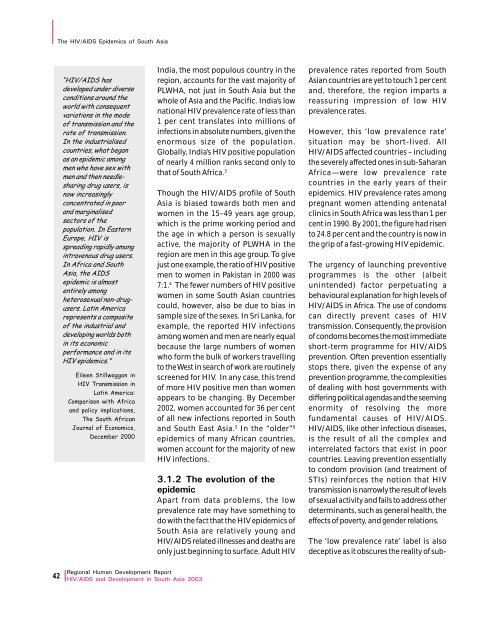Download Report - UNDP Asia-Pacific Regional Centre - United ...
Download Report - UNDP Asia-Pacific Regional Centre - United ...
Download Report - UNDP Asia-Pacific Regional Centre - United ...
Create successful ePaper yourself
Turn your PDF publications into a flip-book with our unique Google optimized e-Paper software.
The HIV/AIDS Epidemics of South <strong>Asia</strong>“HIV/AIDS hasdeveloped under diverseconditions around theworld with consequentvariations in the modeof transmission and therate of transmission.In the industrialisedcountries, what beganas an epidemic amongmen who have sex withmen and then needlesharingdrug users, isnow increasinglyconcentrated in poorand marginalisedsectors of thepopulation. In EasternEurope, HIV isspreading rapidly amongintravenous drug users.In Africa and South<strong>Asia</strong>, the AIDSepidemic is almostentirely amongheterosexual non-drugusers.Latin Americarepresents a compositeof the industrial anddeveloping worlds bothin its economicperformance and in itsHIV epidemics.”Eileen Stillwaggon inHIV Transmission inLatin America:Comparison with Africaand policy implications,The South AfricanJournal of Economics,December 2000India, the most populous country in theregion, accounts for the vast majority ofPLWHA, not just in South <strong>Asia</strong> but thewhole of <strong>Asia</strong> and the <strong>Pacific</strong>. India’s lownational HIV prevalence rate of less than1 per cent translates into millions ofinfections in absolute numbers, given theenormous size of the population.Globally, India’s HIV positive populationof nearly 4 million ranks second only tothat of South Africa. 3Though the HIV/AIDS profile of South<strong>Asia</strong> is biased towards both men andwomen in the 15–49 years age group,which is the prime working period andthe age in which a person is sexuallyactive, the majority of PLWHA in theregion are men in this age group. To givejust one example, the ratio of HIV positivemen to women in Pakistan in 2000 was7:1. 4 The fewer numbers of HIV positivewomen in some South <strong>Asia</strong>n countriescould, however, also be due to bias insample size of the sexes. In Sri Lanka, forexample, the reported HIV infectionsamong women and men are nearly equalbecause the large numbers of womenwho form the bulk of workers travellingto the West in search of work are routinelyscreened for HIV. In any case, this trendof more HIV positive men than womenappears to be changing. By December2002, women accounted for 36 per centof all new infections reported in Southand South East <strong>Asia</strong>. 5 In the “older” 6epidemics of many African countries,women account for the majority of newHIV infections.3.1.2 The evolution of theepidemicApart from data problems, the lowprevalence rate may have something todo with the fact that the HIV epidemics ofSouth <strong>Asia</strong> are relatively young andHIV/AIDS related illnesses and deaths areonly just beginning to surface. Adult HIVprevalence rates reported from South<strong>Asia</strong>n countries are yet to touch 1 per centand, therefore, the region imparts areassuring impression of low HIVprevalence rates.However, this ‘low prevalence rate’situation may be short-lived. AllHIV/AIDS affected countries – includingthe severely affected ones in sub-SaharanAfrica—were low prevalence ratecountries in the early years of theirepidemics. HIV prevalence rates amongpregnant women attending antenatalclinics in South Africa was less than 1 percent in 1990. By 2001, the figure had risento 24.8 per cent and the country is now inthe grip of a fast-growing HIV epidemic.The urgency of launching preventiveprogrammes is the other (albeitunintended) factor perpetuating abehavioural explanation for high levels ofHIV/AIDS in Africa. The use of condomscan directly prevent cases of HIVtransmission. Consequently, the provisionof condoms becomes the most immediateshort-term programme for HIV/AIDSprevention. Often prevention essentiallystops there, given the expense of anyprevention programme, the complexitiesof dealing with host governments withdiffering political agendas and the seemingenormity of resolving the morefundamental causes of HIV/AIDS.HIV/AIDS, like other infectious diseases,is the result of all the complex andinterrelated factors that exist in poorcountries. Leaving prevention essentiallyto condom provision (and treatment ofSTIs) reinforces the notion that HIVtransmission is narrowly the result of levelsof sexual activity and fails to address otherdeterminants, such as general health, theeffects of poverty, and gender relations.The ‘low prevalence rate’ label is alsodeceptive as it obscures the reality of sub-42<strong>Regional</strong> Human Development <strong>Report</strong>HIV/AIDS and Development in South <strong>Asia</strong> 2003
















